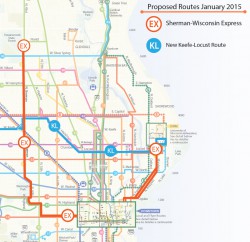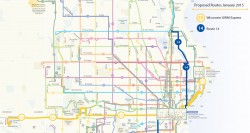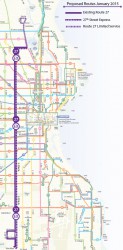Milwaukee’s New Bus System
MCTS is adding express service to more routes.
The Milwaukee County Transit System is planning to unveil new express bus service in January 2015. The new express routes would run from UWM to Brookfield Square Mall via the East Side and Downtown (a variation of today’s Route 10), UWM to N. Sherman Blvd.-W. Florist Ave. via the East Side and Downtown (today’s Route 30), and along 27th Street from W. Hampton Ave. to the Wal-Mart at W. Sycamore Ave (today’s Route 27). The new routes would offer complementary service to existing routes, with a few exceptions for route adjustments.
The new routes would see speed gains primarily by stopping once every quarter mile where there is no underlying service (such as the western end of Wisconsin – UWM Express route where Route 10 service would be eliminated), and once every half mile where there is underlying service (such as the 27th Street Express with the existing Route 27). Today’s bus service generally stops once every eighth of a mile, or approximately every two blocks.
Sherman – Wisconsin Express
The proposed Sherman – Wisconsin Express would add express service to the most heavily used route in the MCTS system. Route 30 currently has an annual ridership of 4,195,000 with branches on each end of the route (Downer/Maryland on the East, Florist/Keefe on the West). The new service would run on the existing Route 30 route, but only serve the N. Maryland Ave. branch on the East end of the route and the N. Sherman Blvd. – W. Florist Ave. branch on the West end.
The new express service would run every day but Sunday with service from 6 a.m. until 9 p.m. Rush hour service would be every 15 minutes, with off-peak headways of 20-30 minutes.
The existing Route 30 would continue to operate under the proposed changes, with service everyday from 5 a.m. until 2 a.m. It would however, eliminate the Downer Ave. branch (to be served by Route 21 and the new Wisconsin – UWM Express) and the Keefe Ave. branch (to be served by a new Keefe – Locust local route).
According to MCTS, the “changes will improve efficiency by providing more service where the demand is the highest.”
Wisconsin – UWM Express
The Wisconsin – UWM Express is proposed to serve Downtown, the Regional Medical Center, Marquette University, UWM and Brookfield Square Mall. It would primarily run in the footprint of Route 10, which would be retired as a route number. The express route isn’t the only route that would replace Route 10 though, Route 14 would be extended from Downtown to Bayshore Town Center on the current Route 10 route. Route 14 currently terminates at the Downtown Transit Center, which might be redeveloped into The Couture. Route 10 today provides 1,832,000 annual rides.
West of 35th Street, the route is proposed to continue on W. Wisconsin Ave in the footprint of today’s 10, but riders could potentially have to walk further to stops. The new stops would be spaced every quarter mile instead of every eighth mile. This change is intended to speed up service in the corridor.
The new express route would run to the East end of Wisconsin Ave. following Prospect Ave. north until it becomes a two-way street at E. Ogden Ave. From there it would follow the Route 30 route to UWM, taking the N. Downer Ave. branch of the service. During this stretch it would overlap the expanded Route 14 and the existing Route 30 (which would have its Downer Ave. leg eliminated).
The new service would run seven days a week, from 5 a.m. until 2 a.m. Rush hour frequencies would have buses arriving every 10-15 minutes, with off-peak headways of 15-20 minutes. Weekend headways would have buses arriving every 20-30 minutes.
27th Street Express
This proposed route is easily the most straight forward of the proposed express routes, it’s also the straightest route. Running from nearly the northern county line to the southern, it would run entirely within the footprint of the existing Route 27. The Route 27, the second highest trafficked in the system with 3,686,000 annual rides, would continue to operate with a slightly reduced schedule as new service is added via the express route. The Route 27 would continue to serve the Glendale Business Park at the north end of the route and the extension over to 35th Street on the south end, while the new route would run only straight north and south on 27th Street.
The new service would run seven days a week from 5 a.m. until 1 a.m., with rush hour frequencies between 15 and 20 minutes and off-peak frequencies of 25-30 minutes. This arrangement would be very similar to today’s Blue Line and Route 23, which overlap for almost all of their routes.
New Keefe – Locust Route
A new route, introduced because of proposed modifications to Route 30, would connect N. 76th St. and W. Appleton Ave. with UWM. It would operate via W. Appleton Ave., W. Keefe Ave., N. Sherman Blvd. W. Capitol Drive., W. Hopkins St. and Locust Ave. The new route would provide connections to a number of routes that run north-south through the area.
The new route would run from 6 am. until 1 .a.m. seven days a week, with service every 35 minutes.
Devil in the Details
These routes are made possible by a grant MCTS received in March of this year, but it’s not all good news. The grant comes the federal Congestion Mitigation and Air Quality (CMAQ) grant program, which has funded a number of things in the Milwaukee area from streetscaping on Wisconsin Ave to new bus purchases. The most recent grant will fund service on the new routes for three years, but was needed as a way to avoid potential service cuts caused by a 10% reduction in state operating support.
This isn’t a new problem for Milwaukee County though. MCTS has been using a CMAQ grant to fund new express service since 2012 and avoid service cuts, but that grant expires at the end of this year. The state aid cuts came in the first budget passed by Governor Scott Walker in 2011 and weren’t restored in the latest budget, despite a budget surplus. In 2013, state aid made up 43% of the transit system’s revenue.
The previous grant funded the creation and operation of the Blue, Green and Red lines which serve corridors formerly served by the 15, 23, and 62 routes (all of those routes continue to exist with modifications). Those routes appear to have been a success, although they’re clearly less about express service and more about a creative way to avoid a service reduction.
How many more times can Milwaukee County pull off a short-term trick to avoid a long-term funding problem?
The system still needs to find a sustainable funding source. While CMAQ grants have enabled the system to avoid serious service cuts, they’re just kicking the can down the road. Fares have already been raised 67% since 2000 ($1.35 to $2.25) and ridership has fallen 29% (58 million rides in 2000, 37 million rides in 2012). Will legislators pull the system out of the death spiral its clearly entered?
Your Opinion
While we would love to hear what you have to say in the comments, you only have through September 17th to submit official feedback to the transit system. In addition, a public meeting is being held tonight at the Milwaukee Public Library’s Central Library from 5 p.m. until 7 p.m. to solicit feedback on the proposed changes.
Eyes on Milwaukee
-
Church, Cupid Partner On Affordable Housing
 Dec 4th, 2023 by Jeramey Jannene
Dec 4th, 2023 by Jeramey Jannene
-
Downtown Building Sells For Nearly Twice Its Assessed Value
 Nov 12th, 2023 by Jeramey Jannene
Nov 12th, 2023 by Jeramey Jannene
-
Immigration Office Moving To 310W Building
 Oct 25th, 2023 by Jeramey Jannene
Oct 25th, 2023 by Jeramey Jannene























Really wish the Keefe route would travel further east on Keefe and around the Union Cemetary. Its an area that really could use a closer east/west route. Locust is already decenlty served with Burliegh two blocks north and Center 2 or 3 blocks south but if you live off of Keefe you have a treck all the way to Capitol or Burliegh to catch a bus.
Looking at the map I would continue east on Keefe to FDL, south to Townsend (were Century City Development is coming together) east to Hopkins, south all the way to Chambers, east to Teutonia, back north to Keefe, East to Humbolt, south to the Locust St bridge.
There are a number of interesting intersection trying to come back to life along that route also most notably and the largest is the Williamsburg Triangle.
So, any intention to turn these and the existing “express” routes into true bus rapid transit? Pretty much all of these routes could handle bus-only lanes. And as a frequent Green Line rider, it would be great to see an actual rapid transit route, not just a bus route that’s slightly quicker than the regular bus.
And if there are no plans, who do we speak to to make it happen?
Good ideas Casey… I think the routing of KL is pretty good considering the start/stop nature of some of the large streets in the area. I’m guessing they have the KL route running as they do, in order to eliminate the overlapping route 80 leg.
I’ve ridden the 80 a couple dozen times … the part that ends at 35th/Capitol isn’t busy at all, the Villard stretch has many more people on it.
I agree with Casey regarding the routing of the new Keefe route.
There used to be bus service on Keefe between Atkinson and Humboldt on the old Route 73. There was a small transit station on the north side of between Atkinson and what is today MLK. Google maps shows an off-street bus shelter there today.
Back in the 1970s and before, there was a brick building on that site owned by the bus company (privately owned back then and not subsidized) which was the start of 3 bus routes:
58: north on Green Bay (MLK today) with separate branches on Hampton (to Hopkins), Villard to Timmerman, and Silver Spring to about 107th)
68: north on Port Washington to Hampton where one branch continued north to Brown Deer (but most runs turned back well south of that at perhaps Good Hope or Bradley) and the other went east on Hampton to Santa Monica then running north to Dean Rd returning via Lake Drive to Silver Spring to Santa Monica. Alternate runs ran in the opposite direction–north on Lake Drive and South on Santa Monica. A few runs made it all the way up to Fairy Chasm.
73: east on Keefe to Humboldt and then north pretty much on what today is Route 10 until about Silver Spring.
In each case (except where Route 73 crossed the Capitol Drive bridge) these buses were the only transit along their entire route.
My parents told me the transit station was originally an interurban station. It still had a heated indoor waiting room into at least the 1970s. Electric trolley bus routes 19 and 37 stopped in front of it on Atkinson.
Two other thoughts on the new Keefe route:
The west end should be extended a few blocks to 76th and Capitol to connect with the “Red” bus and Route 67.
If they indeed route the Keefe bus via Capitol Drive, they shouldn’t use Sherman at all. Instead they should take Roosevelt between Fond du Lac and Capitol. Using Roosevelt would make the route shorter and faster while maintaining all connections and would add service to an underserved area.
Bus only lanes? On an inner city street in Milwaukee where the open parking lanes are already thoroughly abused for reckless speeding? Good luck!
After reading this about MCTS I came across this very timely article http://www.citylab.com/cityfixer/2014/09/why-the-people-in-charge-of-transit-systems-should-be-required-to-actually-ride-transit/379931/
I wasn’t that impressed when I attended the Central Library presentation. There wasn’t any info available online before the presentations, the MCTS staff there were a little vague on the details, and it basically seems like a new attempt to scam the federal gov’t into inadvertently plugging a MCTS budget hole for a few more years with money that really is meant to be used on new service.
If MCTS actually wants to speed up service on these routes then they need to start working with the city on improving bus stops/lanes/etc and put together a capital budget proposal that includes some money for signal priority, bigger buses for the 27 and 30, and better designed bus stops. When I asked a MCTS staffer at the presentation about their involvement in the upcoming repaving project on W. Wisconsin Ave. he didn’t seem to know anything about it. This is for the busiest bus corridor in the entire city…
This si good, beef up the bus system, forget the trolleys. why have a worthless system going in circles sucking up big money and then not have enough buses.
Sam isn’t that just the best example for the total lack of coordinator and communication between city and county government?
@ #2- Keefe & Humboldt is too tight an intersection for busses to turn. I don’t think Holton is much better either. Also, they aren’t really going to name a bus route going through high crime neighborhoods ‘KL’ are they?
If tractor trailers can make it through the intersection I’m sure a bus could. Also remember that there used to be a bus route along here when AMC was still operating.
Milwaukee has needed an express bus solution for a long time. We need the people of Milwaukee to be able to move from their neighborhoods to their jobs freely and quickly without having the cost of a car. As Edward Glaeser said “When American cities have built new rapid-transit stops over the last thirty years, poverty rates have increased near those stops. This doesn’t mean that mass transit was making people poor, but rather poor people value being able to get around without a car. The fact that public transit disproportionally carries and attracts the poor is a benefit not a flaw.” I’m glad they finally made this happen. Maybe we will see some sort of a BRT system next? Heres hoping. Maybe these new express stops will help to decrease vacancies in areas where the new express stops will be going.
Smoke and mirrors– using another federal grant to implement services that must be paid for by local and state taxpayers when the grant runs out . . . then that’s called a “cut back.” No, it’s something we couldn’t afford in the first place, paid for by gift money. It’s just like taking a trip using a gift from grandma, then next year when you still can’t afford to do it (you couldn’t afford it last year either without grandma’s money) say that you’ve had to “cut back” your travels this year. In BOTH cases you’re fooling yourself. I wish we could take instant synchronized snapshots of the interior of buses on each and every route and do a through, hour-by-hour analysis of ridership– we’d learn that we pay drivers night and day to rumble empty behemoths up and down our streets. The lights are always on inside buses– COUNT THE RIDERS you see inside of them. If you believe that a bus system is absolutely necessary, and I do, why is it so wrong to demand that such a vital system be run intelligently? Open up the operation, management and even the ownership of this system to bidders with fresh ideas and better ways of doing things, and listen for the adamant SQUEALS of protest scream endlessly about this, that and the other thing. This isn’t the 1940s, 50s, 60s or 70s … if you believe in mass transit, then let’s redesign a system for the 2020s. Most routes, for most of the day, would be much better served by a blue, yellow and green 15-passenger MCTS VAN. Suddenly, we’d be able to afford regular, meaningful service in all kinds of areas. The behemoth buses can run during the few hours per day and on the few routes that need behemoth vehicles!
Andy, using “15-passenger” vans “for most of the day” would cost MCTS more than its present operation and be less safe and useful for riders.
For starters, a “15-passenger” van would not carry 15 passengers because the driver isn’t a passenger. Also, you probably wouldn’t want front-seat passengers at all because you need space for the fare box and the driver’s personal property: lunch, purse, coat, etc. (Besides, what happens if a front-seat passenger refuses to use a seatbelt?) So your “15-passenger” van is down to 12 or 13 passengers.
Also, federal law requires that all transit vehicles be handicap-accessible, and including space for even 2 wheelchairs would greatly reduce capacity, so you are well below 12 passengers on a “15-passenger van”. (MCTS buses averaged 8.35 passengers in 2012–latest data I could find).
Before you scream about only 8 or 9 passengers on a bus with around 40 seats and a total capacity (including standees) of around 60, keep in mind that these are AVERAGES–they are lower at the ends of routes and higher in the middle, are higher on some days than others, etc.
Also note that the average MCTS Transit Plus van averages 1.18 passengers and that, in Milwaukee, the average privately-owned “vehicle” (a US Census term meaning “car, truck, or van”) carries 0.07 passengers when going to work. (All these “passenger” numbers exclude the driver.)
Vans offer two kinds of savings: initial purchase price and fuel consumption. Twenty-foot vans cost much less than 40-foot buses (around $50,000 vs $350,000), but MCTS would see no savings because the van purchases would be IN ADDITION to today’s rush-hour fleet of 40-foot buses. (Before you gasp at the price difference, remember that vans just don’t hold up like buses; transit buses typically drive over 50,000 stop-and-go miles/year and last 10-12 years, but vans driven that hard would fall apart much sooner.) Also, a larger vehicle fleet would require bigger garages.
Fuel is actually a low cost item. In 2011 (latest data I could find), MCTS spent $10.4 million on “fuel and lubricants” out of a $141 million bus operating budget which comes to 23.2¢ per passenger. Even if dual-fleet operations cut this cost by 50% (and it wouldn’t), the savings would come to under 12¢ per passenger.
The biggest single transit operating cost–the driver’s salary and benefit–would be identical with a van.
Dual-fleet operation as you suggest (switching buses 3 times each weekday–at perhaps 9 am, 2 pm, and 6 pm) would introduce a new cost–the thrice-daily switchovers involving hundreds of buses “deadheading” to and from garages. These cutovers would either require sharply reduced bus service during the interval (or hiring more drivers–killing all your savings).
Vans would have another problem–a van would be slower than a transit bus. When the “middle” passenger gets off, the “right” passenger must first exit the bus and then re-enter (loads of fun at night in the rain). If the “left” passenger exits, up to two other passengers must then leave and re-enter the vehicle (unless people exit through the left door–presenting safety issues and/or additional delays waiting for traffic).
The time a bus spends stopping is very significant to both overall speed and operating cost (a driver’s time is taxpayer money). MCTS stops to board 3 passengers per mile and stops again to discharge 3 passengers–up to 6 stops per mile. When you stop that often, the time spent at each stop really adds up.
Finally, 15-passenger vans are really unsafe vehicles especially when loaded. The National Highway Traffic Safety Administration specifically recommends against using them for school buses, for example. http://www.safercar.gov/Vehicle+Shoppers/Passenger+Van+Safety